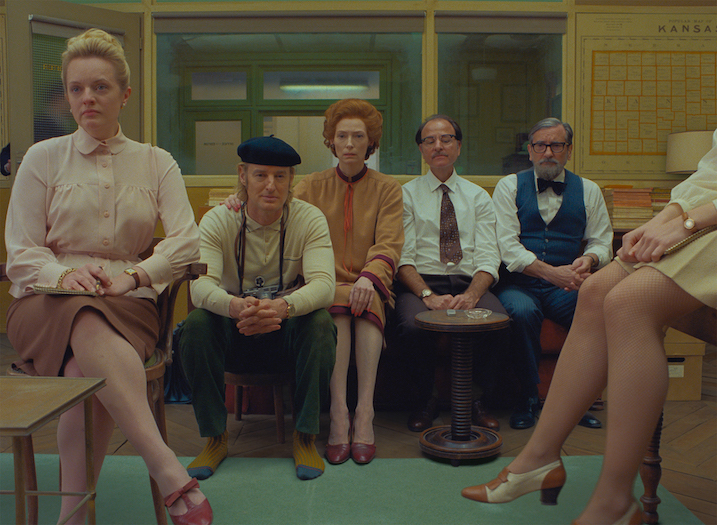‘The French Dispatch’ Is Wes Anderson At His Best And Most Wes (Movie Review)
 Wes Anderson’s tenth studio feature, The French Dispatch, opens wide this weekend. Several regulars, such as Bill Murray, and newcomers like Jeffrey Wright fill the screen cover to cover in an unofficial sendup of The New Yorker. The news that Anderson grew up reading the Big Apple staple should shock no one. What might surprise, however, is how the film uses the layout of a magazine to tell multiple stories anthologically. Officially titled, The French Dispatch of the Liberty, Kansas Evening Sun, this is a Wes Anderson film through and through. For better and well, honestly, there is no worse to be had. It’s a delight.
Wes Anderson’s tenth studio feature, The French Dispatch, opens wide this weekend. Several regulars, such as Bill Murray, and newcomers like Jeffrey Wright fill the screen cover to cover in an unofficial sendup of The New Yorker. The news that Anderson grew up reading the Big Apple staple should shock no one. What might surprise, however, is how the film uses the layout of a magazine to tell multiple stories anthologically. Officially titled, The French Dispatch of the Liberty, Kansas Evening Sun, this is a Wes Anderson film through and through. For better and well, honestly, there is no worse to be had. It’s a delight.

We live in an era that caters to superheroes and their four-paneled origins. Many movie adaptations have used comic book techniques to showcase the colorful thrills of Superman, Hulk, and Spider-Man. Yet, it never occurred to yours truly, until seeing The French Dispatch, that Anderson’s boxy dollhouse compositions are a perfect fit for bringing a crowded two-dimensional zine layout to life too. Like an issue from DC or Marvel, each frame is meticulously curated. There are no less than a hundred sets utilized in the film’s tight 104 minutes. Each scene delivers tons of information, sometimes in a single take… unless the setting calls for the use of negative space.
The first big story of the film is such a venture. Lifer inmate Moses (Benicio) is also a modern art painter discovered by an art dealer, Julian (Adrian Brody). Julian sees dollar signs in the paintings more than the human being the art is based on, namely, prison guard Simone (Lea Seydoux), who poses in the nude. This is modern art, though, so one can’t blame Julian for not seeing Simone as she is merely implied in several abstracts of Moses. Anderson shoots most of this tale in black & white, often against plain white backgrounds of the prison. Isolation is key.

Conversely, the main structure of the film is overcrowded as we’re witnessing several contributors of “The French Dispatch” recount their pieces for the magazine. The second tale centers on Lucinda’s (Frances McDormand) covering of the French students uprising of 1968. Her main subject is Zeffirelli, played by Dune‘s own Timothy Chalamet. The third story (also the strongest) is told by Roebuck (Jeffrey Wright), a spiritual stand-in for the late great James Baldwin. Roebuck remembers a story that involves a kidnapping and deliciously poisoned food. There’s even a section that suddenly becomes animated.
Like The Grand Budapest Hotel, Anderson plays with aspect ratio, color saturation, and the aforementioned black & white cinematography. Frequent collaborator, editor Andrew Weislbum, balances all of this seamlessly. It’s the opposite effect of what Olive Stone was going for in Natural Born Killers, where each film stock change up was meant to be noticed. I’m sure re-watches will offer more and more.

As with all of Anderson’s best work like Budapest, Rushmore, and The Royal Tenenbaums, this is a clashing of the history (real or imagined) of likable yet extremely flawed people. No filmmaker working today has such a grasp on how to display such individuals. The common (and I think mostly shallow) reading of Anderson’s films tends to focus on his supposed quirkiness. I’ve never felt that way. I see those “quirks” as opportunities to reveal a genuine human connection between the filmmaker’s sometimes too perfectly staged artifice and the vulnerable characters that live within their dollhouse worlds. These are not jokes to lighten the stakes like in an MCU flick, but humor is, um, “dispatched” to highlight more about the characters.
The French Dispatch of the Liberty, Kansas Evening Sun is one of the year’s best films so far. The cast is impeccable, the art direction and costumes are top-notch. Best of all, as with all his best work, this is a very funny film.
![]()
![]()
![]()
![]()



















